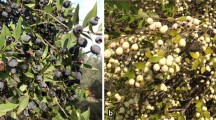Summary
The mineral composition of leaves and fruits of two myrtle genotypes with yellowish-white and purple-black fruits from Çandır village (Isparta) and a genotype with yellowish-white fruits from Serik (Antalya), all of which had high fruit quality, was determined in this study. The results of the study showed that both leaves and fruits of myrtle were rich in K, Ca, Mg, and P contents. No significant correlation could be found between the fruit colors (purple-black and yellowish-white) and mineral contents of the genotypes. The highest total minerals were obtained from Genotype 11 (with purple-black fruits) for the leaf samples but from Genotype 17 (with yellowish-white fruits) for the fruit samples.
Zusammenfassung
Von zwei Genotypen der Myrte, einmal mit blassgelben und einmal mit dunkelvioletten Früchten aus Çandır (Isparta), und einem Genotyp mit blassgelben Früchten aus Serik (Antalya), alle mit guter Fruchtqualität, wurden die Mineralstoffgehalte in Blättern und Früchten bestimmt. Die Ergebnisse der Untersuchung zeigten, dass sowohl Blätter als auch Früchte einen hohen K-, Ca-, Mg- und P-Gehalt aufwiesen. Es konnte keine signifikante Korrelation zwischen den Fruchtfarben (dunkelviolett und blassgelb) und den Mineralstoffgehalten gefunden werden. Der höchste Mineralstoffgehalt wurde beim Genotyp 11 (mit dunkelvioletten Früchten) in den Blattproben und beim Genotyp 17 (mit blassgelben Früchten) in den Fruchtproben festgestellt.
Similar content being viewed by others
References
Ağaoğlu YS (1987) Üzümsü meyveler. Ankara Üniversitesi Ziraat Fakültesi Yayınları: 984 Ders Kitabı: 290, Ankara
Avcı AB, Bayram E (2008) Effect of different harvesting time on the essential oil rates of Myrtle (Myrtus communis L.). J Nat Appl Sci 12:178–181 (Suleyman Demirel University)
Baytop T (1997) Türkçe bitki adları sözlüğü. Türk Dil Kurumu Yayınları, Ankara (No: 578)
Erdal I, Kepenek K, Kızılgöz I (2006) Effects of elemental sulphur and sulphur containing waste on the iron nutrition of strawberry plants grown in a calcareous soil. Biol Agric Hortic 23:263–272
Flamini G, Cioni PL, Morelli I, Maccioni S, Baldini R (2004) Phytochemical typologies in some populations of Myrtus communis L. on Caprione Promontory (East Liguria, Italy). Food Chem 85:599–604
Gözlekçi Ş, Gübbük H (2009) Batı Akdeniz florasında yetişen beyaz ve mor mersin tiplerinin (Myrtus communis L.) bazı fiziksel ve kimyasal özellikler ile mineral besin maddesi içerikleri yönünden kıyaslanması. III. Ulusal Üzümsü Meyveler Sempozyumu Kahramanmaraş
Hacıseferoğulları H, Ozcan MM, Arslan D, Unver A (2012) Biochemical composition and technological characterization of black and white myrtle (Myrthus communis L.) fruits. J Food Sci Technol 49:82–88
Oğur R (1994) A review about myrtle (Myrtus communisL.). Ekoloji 10:21–25
Özcan M, Akbulut M (1998) Some physical and chemical properties of myrtle (Myrtus communis L.). Gıda 23:121–123
Özcan MM, Akbulut M (2007) Estimation of minerals, nitrate and nitrite contents of medicinal and aromatic plants used as spices, condiments and herbal tea. Food Chem 106:852–858
Özcan MM, Ünver A, Uçar T, Arslan D (2008) Mineral content of some herbs and herbal teas by infusion and decoction. Food Chem 106:1120–1127
Özkan AMG, Güray ÇG (2009) A mediterranean: Myrtus communis L. (myrtle). Plants and culture: seeds of the cultural heritage of Europe-©2009. Edipuglia s.r.l., www.edipuglia.it
Penauelas J, Filella I, Tognettir R (2001) Leaf mineral concentrations of Erica arborea, Juniperus communis and Myrtus communis growing in the proximity of a natural CO2 spring. Glob Chang Biol 7:291–301
Sumbul S, Ahmad MA, Asif M, Akhtar M (2011) Myrtus communis Linn. A review. Indian J Nat Prod Resour 2:395–402
Author information
Authors and Affiliations
Corresponding author
Rights and permissions
About this article
Cite this article
Yildirim, F., Şan, B., Yildirim, A. et al. Mineral Composition of Leaves and Fruit in Some Myrtle (Myrtus communis L.) Genotypes. Erwerbs-Obstbau 57, 149–152 (2015). https://doi.org/10.1007/s10341-015-0243-9
Received:
Accepted:
Published:
Issue Date:
DOI: https://doi.org/10.1007/s10341-015-0243-9




